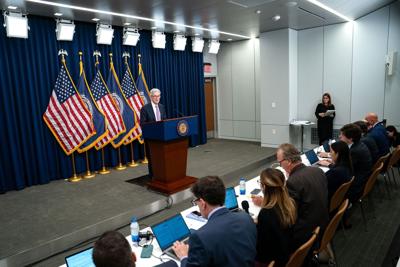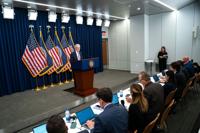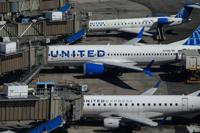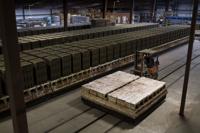Washington (CNN) 鈥� The Federal Reserve on Wednesday the third rate cut since it began to lower borrowing costs in September.
The central bank鈥檚 latest move leaves its benchmark lending rate at a range of 4.25%-4.5%, a two-year low.
The decision to cut was not unanimous, is an attempt to ease pressure on America鈥檚 economy from elevated interest rates to preserve the labor market鈥檚 health.
Fed Chair Jerome Powell said the latest rate cut was 鈥渁 closer call,鈥� adding that recent inflation readings were 鈥渢he single biggest factor鈥� on officials鈥� minds during the meeting. Cleveland Fed President Beth Hammack was the lone dissenter on Wednesday鈥檚 decision, preferring to keep rates at their current levels.
The Fed signaled in its policy statement that it is leaning toward holding rates steady in the future, since inflation remains stubbornly above the central bank鈥檚 2% target. The US economy has also proved in the face of elevated borrowing costs, giving the Fed some reassurance that it can stand pat without risking any undue economic damage.
Fed officials penciled in just two rate cuts for next year, according to their latest forecasts, down from the four they projected in September. Officials also project slightly stronger economic growth, slightly lower unemployment, and for inflation in 2025 to be higher than they previously thought.
The projections overall suggest Fed officials expect the US economy next year to be buoyant, with no recession in sight. They expect inflation to reach their target over a longer period than they previously estimated, not touching 2% until 2027.
Powell sang the US economy鈥檚 praises in his post-meeting news conference, saying its strength has been 鈥渢he story鈥� of the year. Powell affirmed the likelihood of fewer rate cuts next year that the projections showed.
That with the Dow dropping by more than 1,000 points.
Some investors are bullish on the prospects of strong growth next year, which could come about from the policies of President-elect Donald Trump. The incoming administration promises extending the 2017 tax cuts and cutting down on regulations 鈥� policies poised to boost growth if they鈥檙e enacted.
However, Trump鈥檚 threat of massive tariffs on goods coming from Mexico, Canada and China could derail the Goldilocks economy the Fed has seen so far, since the stiff tariffs Trump has floated are widely expected to stoke inflation.
A former Fed president told CNN that the US economy has already achieved the exceptionally rare feat of a 鈥渟oft landing鈥� 鈥� a scenario in which inflation is tamed without a recession 鈥� and is now just a matter of sustaining it.
Here are key takeaways from the Fed鈥檚 third consecutive rate cut.
Powell on what could be in store for 2025
The US economy next year is widely expect to remain solid, according to the Fed鈥檚 own estimates and those of other economists.
Trump has indeed floated plans that could transform the economy, such as high tariffs and mass deportations, but it will generally take time for those plans, if they鈥檙e signed into law, to affect the broader economy.
But for now, the Fed sees a robust US economy with some stubborn price pressures in 2025.
鈥淚 think that the slower pace of cuts for next year really reflects both the higher inflation rate this year and the expectation inflation will be higher,鈥� Powell said.
The Fed leader said that some officials already began to incorporate possible changes in trade policy in to their economic models. Officials regularly devise simulations to understand what the economy might look like in the future.
In September 2018, when the first Trump administration went on a tariff spree, slapping duties on foreign goods ranging from solar panels to washing machines, a Fed simulation if foreign countries imposed retaliatory tariffs and if Americans also expected inflation to pick up, according to a declassified 2018 Fed document detailing policy alternatives known as the 鈥渢ealbook.鈥�
Powell continued to express that there are still many unknowns about Trump鈥檚 tariff plans, such as which goods will be tariffed and the duration of any duties, saying it 鈥渋s not a question that鈥檚 in front of us right now.鈥�
He didn鈥檛 rule out a rate hike in 2025.
Powell on US economic growth and the labor market
US economic growth this year has been healthy, driven by American shoppers continuing to open their wallets. Consumer spending, which accounts for about two-thirds of the US economy, has been boosted by a steady job market with historically low unemployment.
Businesses have also continued to invest in their operations throughout the year, according to Commerce Department data.
Powell said that persistent strength has been one key reason why long-term interest rates, tied to the benchmark 10-year US Treasury yield have trended up since the Fed鈥檚 first rate cut in September.
鈥淢ost forecasters have been calling for a slowdown in growth for a very long time, so we we鈥檙e now well into another year of growth鈥� that looks strong, he said. 鈥淭he US economy is just performing very, very well.鈥�
Powell had a measured tone when describing the labor market, noting that it 鈥渋s still cool by many measures鈥� but 鈥渘ot cooling quick or in a way that really breaks.鈥� He said that the labor market is not a source of inflation pressure, adding that the Fed isn鈥檛 aiming to see any further softening in activity, which could be either higher unemployment or slower monthly job market.
鈥淭his is a good labor market and we want to keep it that way,鈥� Powell said.
Overall, America鈥檚 economy remains in good shape, but high inflation isn鈥檛 in the rearview mirror just yet. Recent inflation readings have reflected persistent price pressures in housing and a pick-up in prices for food and some goods.
Put together, economic data makes a strong case for the Fed to hold rates steady until inflation鈥檚 downward trend gets back on track. Officials鈥� latest projections show that inflation won鈥檛 reach the Fed鈥檚 target until 2027, a year later than what they estimated in September.
The-CNN-Wire
鈩� & 漏 2024 Cable News Network, Inc., a Warner Bros. Discovery Company. All rights reserved.














